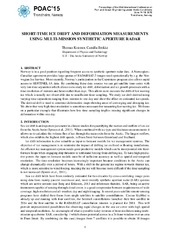Blar i forfatter "Kræmer, Thomas"
-
Comparing SAR based short time-lag cross-correlation and Doppler derived sea ice drift velocities
Kræmer, Thomas; Johnsen, Harald; Brekke, Camilla; Engen, Geir (Journal article; Tidsskriftartikkel; Peer reviewed, 2017-11-23)This paper shows initial results from estimating Doppler radial surface velocities (RVLs) over Arctic sea ice using the Sentinel-1A (S1A) satellite. Our study presents the first quantitative comparison between ice drift derived from the Doppler shifts and drift derived using time-series methods over comparable time scales. We compare the Doppler-derived ice velocities with global positioning system ... -
Deep Semisupervised Teacher–Student Model Based on Label Propagation for Sea Ice Classification
Khaleghian, Salman; Ullah, Habib; Kræmer, Thomas; Eltoft, Torbjørn; Marinoni, Andrea (Journal article; Tidsskriftartikkel; Peer reviewed, 2021-10-14)In this article, we propose a novelteacher–student-based label propagation deep semisupervised learning (TSLP-SSL) method for sea ice classification based on Sentinel-1 synthetic aperture radar data. For sea ice classification, labeling the data precisely is very time consuming and requires expert knowledge. Our method efficiently learns sea ice characteristics from a limited number of labeled samples ... -
Emulating sentinel-1 Doppler radial ice drift measurements using envisat ASAR data
Kræmer, Thomas; Johnsen, Harald; Brekke, Camilla (Journal article; Tidsskriftartikkel; Peer reviewed, 2015-08-05)Using data from the Envisat Advanced Synthetic Aperture Radar (ASAR) instrument, this paper demonstrates how the high-precision radial surface velocity product, which will become available with the European Space Agency's Sentinel-1 satellite, can complement the analysis of sea ice motion. High-resolution Doppler frequency measurements are used to estimate the subsecond line-of-sight motion of ... -
ExtremeEarth meets satellite data from space
Hagos, Desta Haileselassie; Kakantousis, Theofilos; Vlassov, Vladimir; Sheikholeslami, Sina; Wang, Tianze; Dowling, Jim; Paris, Claudia; Marinelli, Daniele; Weikmann, Giulio; Bruzzone, Lorenzo; Khaleghian, Salman; Kræmer, Thomas; Eltoft, Torbjørn; Marinoni, Andrea; Pantazi, Despina-Athanasia; Stamoulis, George; Bilidas, Dimitris; Papadakis, George; Mandilaras, George; Koubarakis, Manolis; Troumpoukis, Antonis; Konstantopoulos, Stasinos; Muerth, Markus; Appel, Florian; Fleming, Andrew; Cziferszky, Andreas (Journal article; Tidsskriftartikkel; Peer reviewed, 2021-08-26)Bringing together a number of cutting-edge technologies that range from storing extremely large volumes of data all the way to developing scalable machine learning and deep learning algorithms in a distributed manner and having them operate over the same infrastructure poses unprecedented challenges. One of these challenges is the integration of European Space Agency (ESA)’s Thematic Exploitation ... -
Improving Doppler frequency estimation from Envisat data
Kræmer, Thomas; Johnsen, Harald; Brekke, Camilla (Journal article; Tidsskriftartikkel; Peer reviewed, 2014-11-06)This paper shows that Envisat ASAR data are degraded by a small periodic variation in gain between internal calibration cycles of the antenna, which introduces a significant bias when we try to estimate line-of-sight surface velocities from the estimated Doppler frequency shifts. We investigate the impact of the gain problems on the derived surface velocity product and propose a simple correction ... -
Improving Doppler frequency estimation from Envisat data
Kræmer, Thomas; Johnsen, Harald; Brekke, Camilla (Conference object; Konferansebidrag, 2014) -
Satellittovervåking av isdrift i Arktis
Kræmer, Thomas (Conference object; Konferansebidrag, 2013) -
Sea Ice Classification of SAR Imagery Based on Convolution Neural Networks
Khaleghian, Salman; Ullah, Habib; Kræmer, Thomas; Hughes, Nick; Eltoft, Torbjørn; Marinoni, Andrea (Journal article; Tidsskriftartikkel; Peer reviewed, 2021-04-29)We explore new and existing convolutional neural network (CNN) architectures for sea ice classification using Sentinel-1 (S1) synthetic aperture radar (SAR) data by investigating two key challenges: binary sea ice versus open-water classification, and a multi-class sea ice type classification. The analysis of sea ice in SAR images is challenging because of the thermal noise effects and ambiguities ... -
Short-Time Ice Drift and Deformation Measurements Using Multi-Mission Synethetic Aperture Radar
Kræmer, Thomas; Brekke, Camilla (Journal article; Tidsskriftartikkel, 2015-06)Norway is in a good position regarding frequent access to synthetic aperture radar data. A Norwegian– Canadian agreement provides large quotas of RADARSAT-2 images used operationally by e.g. the Norwegian Ice Service. More recently, Norway’s participation in the Copernicus program also allows rapid access to SENTINEL-1A data. By combining these data sources we can get satellite time series ...


 English
English norsk
norsk







